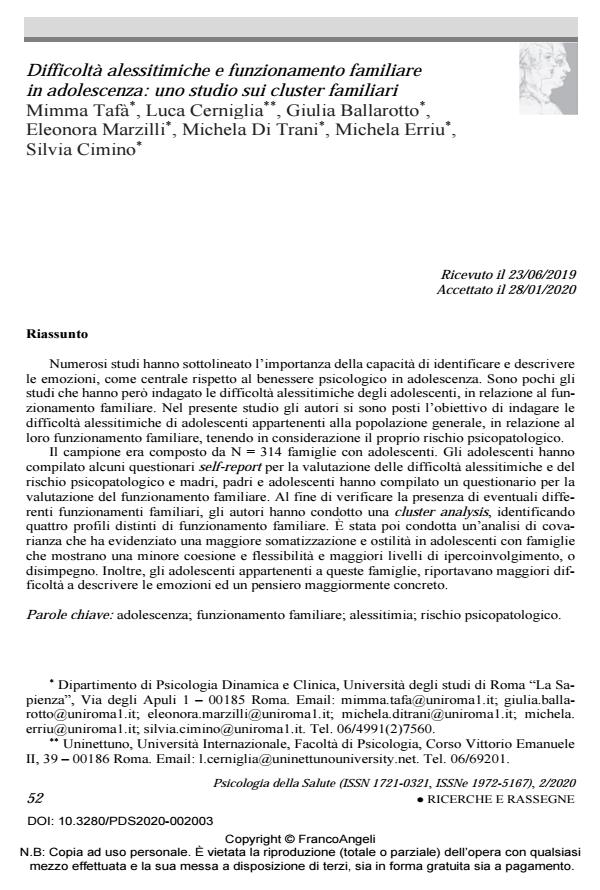Difficoltà alessitimiche e funzionamento familiare in adolescenza: uno studio sui cluster familiari
Titolo Rivista PSICOLOGIA DELLA SALUTE
Autori/Curatori Mimma Tafà, Luca Cerniglia, Giulia Ballarotto, Eleonora Marzilli, Michela Di Trani, Michela Erriu, Silvia Cimino
Anno di pubblicazione 2020 Fascicolo 2020/2
Lingua Italiano Numero pagine 19 P. 52-70 Dimensione file 286 KB
DOI 10.3280/PDS2020-002003
Il DOI è il codice a barre della proprietà intellettuale: per saperne di più
clicca qui
Qui sotto puoi vedere in anteprima la prima pagina di questo articolo.
Se questo articolo ti interessa, lo puoi acquistare (e scaricare in formato pdf) seguendo le facili indicazioni per acquistare il download credit. Acquista Download Credits per scaricare questo Articolo in formato PDF

FrancoAngeli è membro della Publishers International Linking Association, Inc (PILA)associazione indipendente e non profit per facilitare (attraverso i servizi tecnologici implementati da CrossRef.org) l’accesso degli studiosi ai contenuti digitali nelle pubblicazioni professionali e scientifiche
Numerosi studi hanno sottolineato l’importanza della capacità di identificare e descrivere le emozioni, come centrale rispetto al benessere psicologico in adolescenza. Sono pochi gli studi che hanno però indagato le difficoltà alessitimiche degli adolescenti, in relazione al funzionamento familiare. Nel presente studio gli autori si sono posti l’obiettivo di indagare le difficoltà alessitimiche di adolescenti appartenenti alla popolazione generale, in relazione al loro funzio-namento familiare, tenendo in considerazione il proprio rischio psicopatologico. Il campione era composto da N = 314 famiglie con adolescenti. Gli adolescenti hanno compilato alcuni questionari self-report per la valutazione delle difficoltà alessitimiche e del rischio psicopatologico e madri, padri e adolescenti hanno compilato un questionario per la valutazione del funzionamento familiare. Al fine di verificare la presenza di eventuali differenti funzionamenti familiari, gli autori hanno condotto una cluster analysis, identificando quattro profili distinti di funzionamento familiare. È stata poi condotta un’analisi di covarianza che ha evidenziato una maggiore somatizzazione e ostilità in adolescenti con famiglie che mostrano una minore coesione e flessibilità e maggiori livelli di ipercoinvolgimento, o disimpegno. Inoltre, gli adolescenti appartenenti a queste famiglie, riportavano maggiori difficoltà a descrivere le emozioni ed un pensiero maggiormente concreto.
Parole chiave:Adolescenza; funzionamento familiare; alessitimia; rischio psicopatologico
Mimma Tafà, Luca Cerniglia, Giulia Ballarotto, Eleonora Marzilli, Michela Di Trani, Michela Erriu, Silvia Cimino, Difficoltà alessitimiche e funzionamento familiare in adolescenza: uno studio sui cluster familiari in "PSICOLOGIA DELLA SALUTE" 2/2020, pp 52-70, DOI: 10.3280/PDS2020-002003